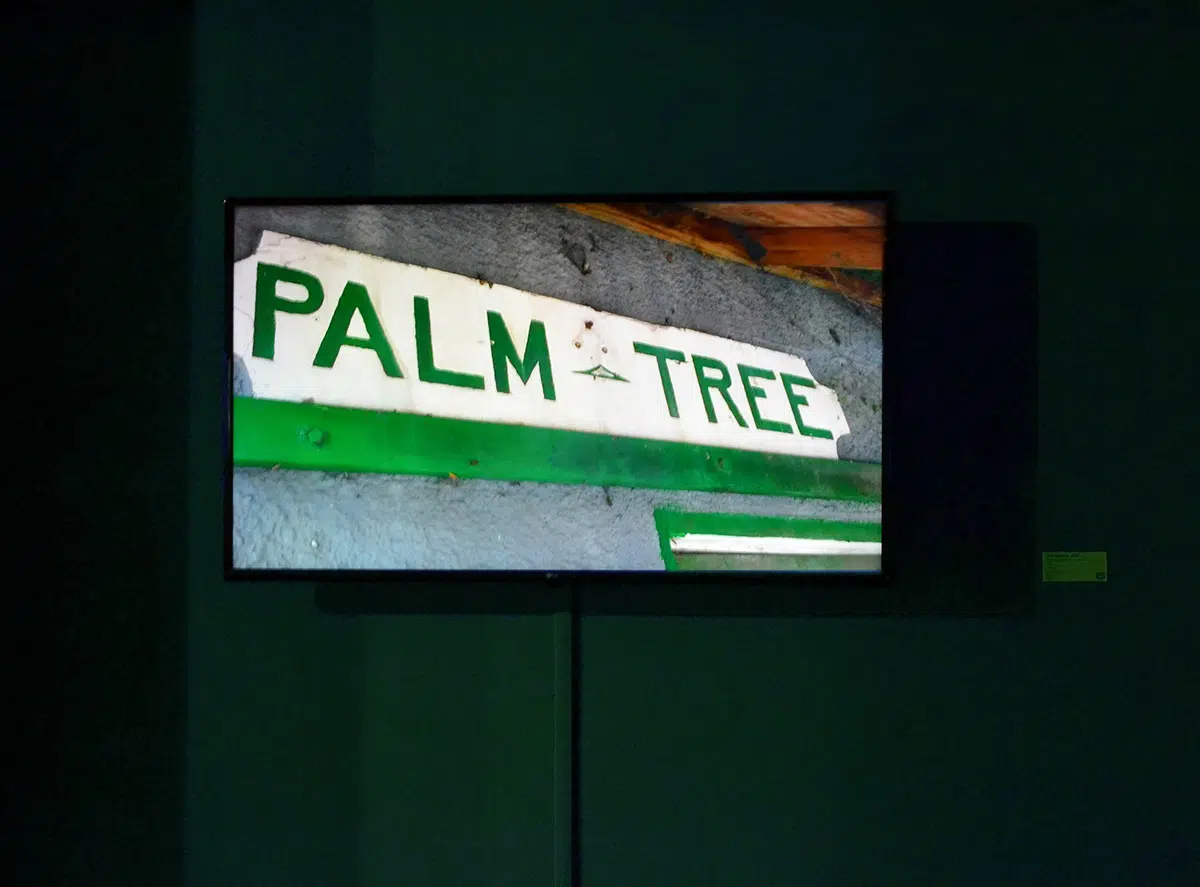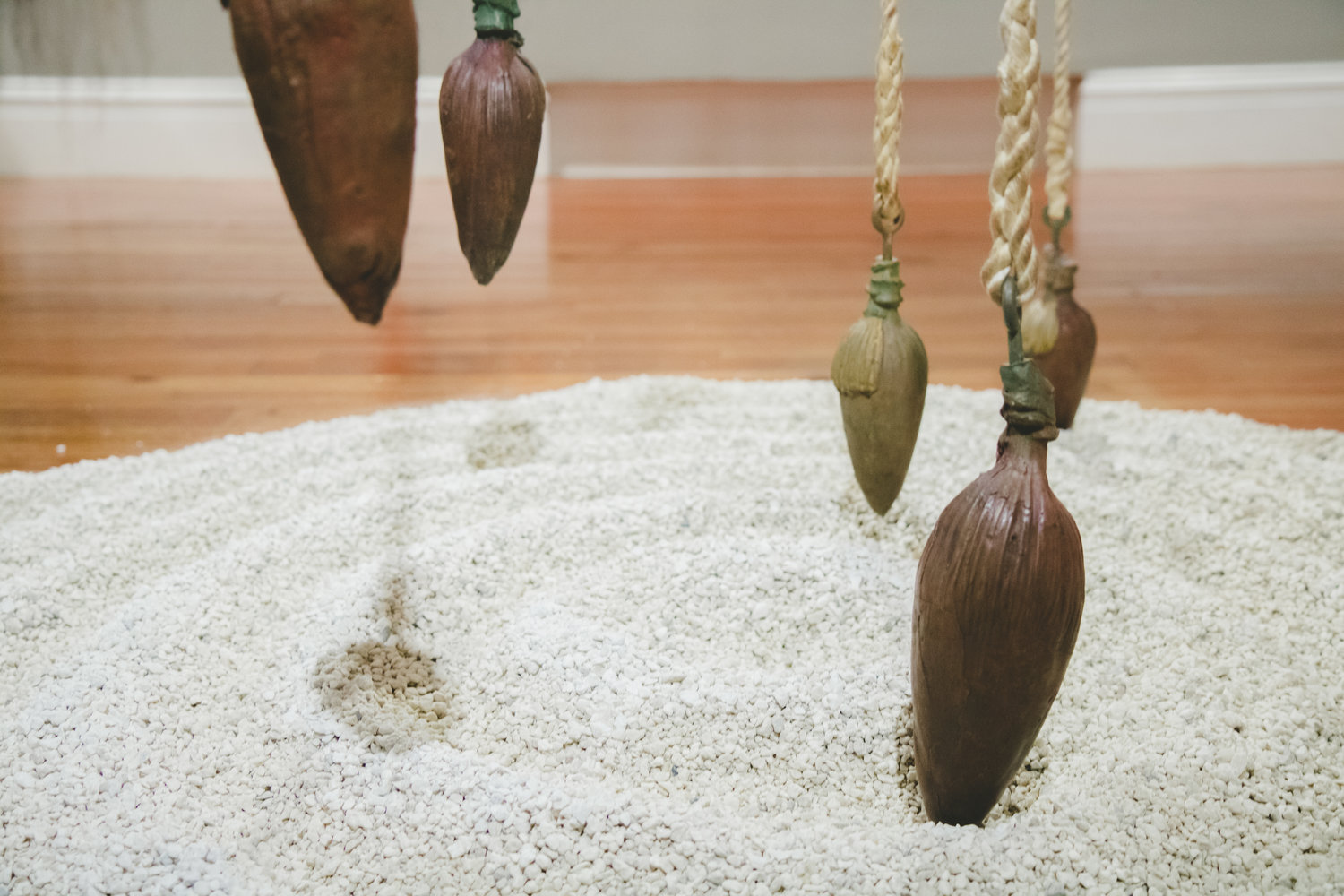Push Out: Jodi Minnis and Ian Bethell-Bennett Investigate the Mythologies and Futures of Gentrification in Over-the-Hill

The set up is simple. Before us, a split-screen video projection with sounds of “ole nassau” and a passenger-seat view of Downtown, Over-the-Hill (OTH), and archival footage. Behind, a TV laying out the names, places, and stories of the soul, music and culture hot-spots in Bain and Grants Town “back in the day” along with the more newly developed buildings taking their place or the ruins that belie their thriving past. Emerging artist Jodi Minnis, along with University of The Bahamas’ (UB) Associate Professor of Liberal and Fine Arts Dr. Ian Bethell-Bennett, take us on a journey in quite a literal sense. We get a passenger-seat view through the streets of downtown Nassau, but also a more figurative journey through time, and indeed through the hot-button topics of gentrification and community development. In fitting with the NE9’s open call asking for publicly engaged or informed projects, and the National Art Gallery of The Bahamas (NAGB) aptly perched between the economic tourist center that is Bay Street and OTH, Minnis and Bethell-Bennett remind us just by sitting in the bones of the Villa Doyle (which houses the NAGB), we are in the midst of this ongoing development in the country’s capital.
Within the film there is a clear delineation given to account for the differences between gentrification and community development. The former, gentrification, being the development of an area that results in the displacement of (more often than not) the working class people out of the neighborhoods they inhabit. The latter, community development, a more ethically and humanitarian-minded approach to empower neighborhoods and communities without the risk of displacing its inhabitants – these are most often plans intended to increase the quality of life and living space for those residing there.
For Minnis, “Often “historic” Nassau becomes a romanticized mysticism, and by pairing footage of that time when it was thriving, with footage of the current state of the space brings that back to a critical reality for today.” With gentrification, those living in an area are subject to the whims and plans of more powerful, outside entities, encroaching on the space until it is no longer viable for the (often marginalized) inhabitants to continue living there. Whereas with community development, it’s quite the opposite, wherein those that call these neighborhoods home are given agency and autonomy and empowered to create change for themselves within their own spaces.
Bethell-Bennett is also not convinced with the current, prevailing narrative of OTH as an historically impoverished place: “Old Nassau was dependent on Over-the-Hill because that was where tourists went for entertainment. It was also where Bahamian music was alive, prior to desegregation and the hotels taking over the local bands and paying them more than clubs could. The representation of the area as nothing but a ghetto was historically misplaced and inaccurate.”
The pair, who began this particular journey through expression of shared interest when Minnis came to Bethell-Bennett as part of her research for a paper on gentrification she was undertaking as part of her undergraduate studies, help us to bust open the mythology and stereotypes of Over-the-Hill as a currently underserved area, as well as what exactly it means to navigate gentrification as art and cultural workers. There has been much discussion in the past few years of the role of art and museums in the act of gentrification – the bolstering of the beast, and the attempts to stop its steam-rolling progression forward, fueled by often ruthless capitalist agendas, as it displaces any and all in its path.
Minnis shares: “Once a space thriving with Black businesses, nightclubs, and hotels, the OTH community seems to now be at a standstill. Both the University and The Pointe’s expansion are imminent, especially the university. Young boys from Bain and Grants Town walking to the beach are already heavily policed to ensure the “safety” of tourists; so imagine having people living alongside said beach? I am not opposed to the expansion of the university, it is necessary. However, the line between community development and gentrification is quite fine and I do hope that any developments of either entity lean towards community development.”
It’s a tension we see and feel often. With the ocean view locals are accustomed to constantly being swallowed up by new hotels or private homes or office blocks, it’s not hard to see directly the way this functions. Our once-easy access to the water is no longer, and in its wake we often see the historic edifices and buildings at its margins being wiped away to make room for yet another luxury space for the privileged.
Bethell-Bennett, having worked on the team for the National Development Plan that was shelved a few years back, along with his own experiences living in parts of Puerto Rico and London that have seen gentrification take its hold, knows what this looks like, he’s seen it over and over. “We see similar examples of gentrification on many other islands like BVI, Antigua and Barbuda and Puerto Rico, for example. However, because we are so close to the US, we have a totally different relationship with US expansionism after Manifest Destiny. This really took off in the early 2000s, though it began slowly after the FNM came to power. That said, much of what we see as Bahamian land has never really been owned by The Bahamas; it has always been given or bequeathed to someone else. Education does not teach us that nor does nationalism. As much as the subsequent governments talk about Freeport and equate it with Grand Bahama, you know that these are two different realities and one is private and so otherwise constructed and performed into being.” But the show we are currently performing is less jazz-club and, like most of the Caribbean, perhaps more akin to a slow motion accident.
The pair shares similar sentiments on what more ethical modes of development for Nassau look like. Bethell-Bennett believes: “We have to empower people through education, but also we must create awareness that if we sell off everything we will be a nation without a home or a people without a nation. London is such an amazing example of pushing poverty out of sight, and while we consider ourselves to be more American, English Law reigns supreme and so much is used to dispossess because so few had historically possessed. The politicians would have to change and the awareness of spatial injustice and legal inequality would have to grow. It is still very much a pirate’s republic or a privateer’s paradise.”
For Minnis, the answer is also simple, not only do we need more education outside of the often problematic narratives we share (and so believe ourselves), but we also need more agency and autonomy into our underserved communities and empower them to do so: “I believe the best way to balance this is to invest directly into grassroot efforts and already established systems of community development. Let the people decide what is best for them and allow a natural evolution of the space once money has begun to continuously flow. Keep people informed of the cultural and historic significance of their land outside of the often-white, often-outsider gaze.”
Spend time with this work at the NAGB as part of the NE9: The Fruit and The Seed, on view through April 7, 2019.
